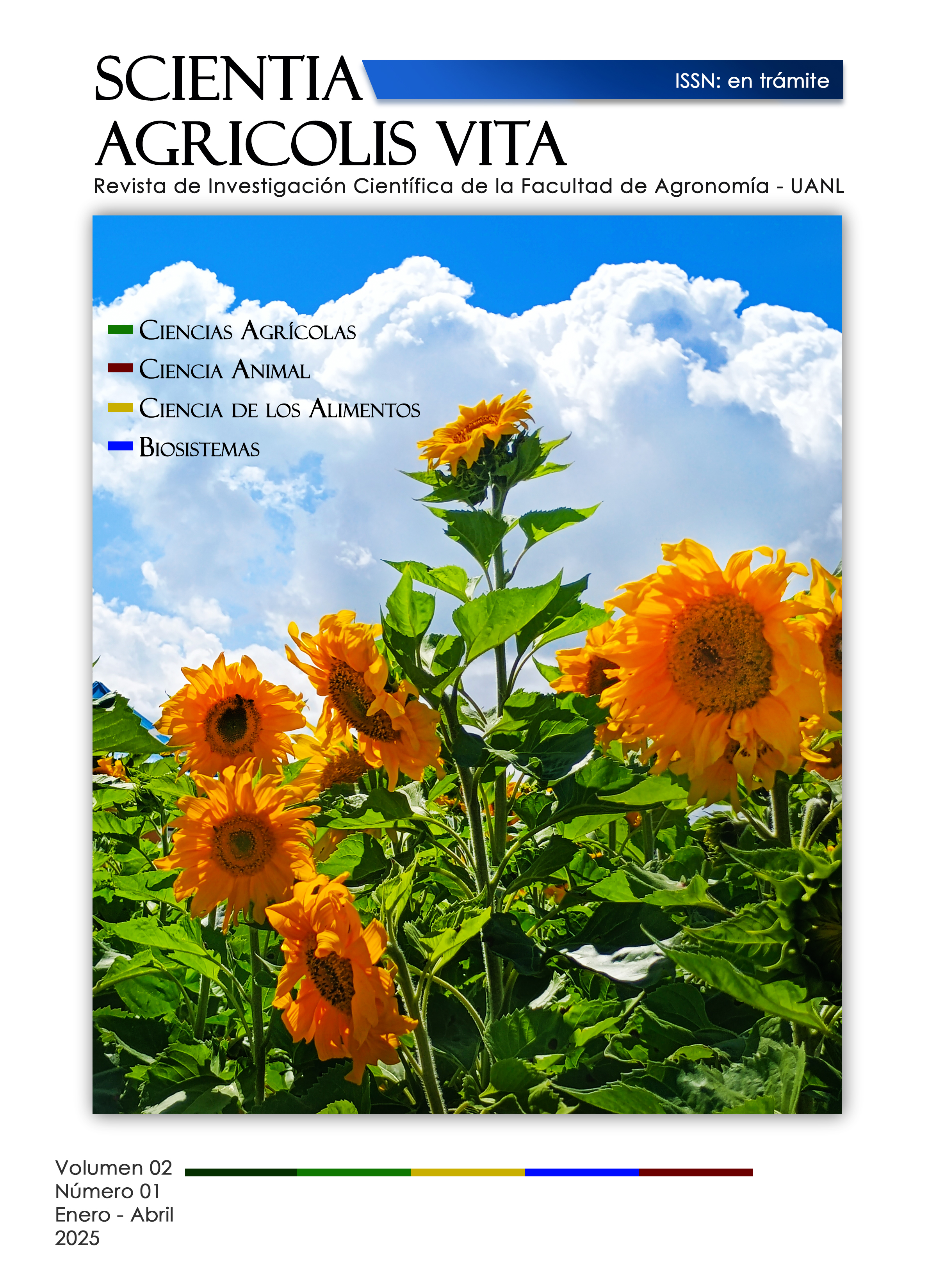Evaluation of tropical and subtropical maize hybrids in a transitional climate
Evaluation of maize hybrids
DOI:
https://doi.org/10.29105/agricolis.v2i1.24Keywords:
Adaptation, Agronomic characteristics, Cob characteristics, Yield components, Grain yieldAbstract
The municipality of Tonila, Jalisco, Mexico is in a transition zone among warm subhumid, temperate semi-warm subhumid and temperate humid climates, hence producers are in a constant search for maize hybrids to increase grain production. For the above, this study aimed to evaluate the productive performance of four commercial corn hybrids under the climatic conditions of Tonila, Jalisco, Mexico. The subtropical hybrids Don Pepe, ZR-22 and Titanio and the tropical hybrid Río Blanco 16 were planted under rainfed conditions at a density of 85 000 plants ha-1, under a completely randomized experimental design, with 10 replicates. Agronomic and cob characteristics and yield components were measured. The subtropical hybrid ZR-22 stood out for being earlier and showing the greatest cob length, number of grains per row and per cob, and grain weight and yield.
Downloads
References
1. Aldrich, S.R. (1974). Producción moderna del maíz. Hemisferio Sur. Buenos Aires, Argentina.
2. Ángeles-Gaspar, E., Ortiz-Torres, E., López, P. A., y López-Romero, G. (2010). Caracterización y rendimiento de poblaciones de maíz nativas de Molcaxac, Puebla. Revista Fitotecnia Mexicana. 33: pp 287-296. doi:10.35196/rfm.2010.4.287
3. Borroel-García, V.J., Salas-Pérez, L., Ramírez Aragón, M. G., López-Martínez, J. D., and Luna-Anguiano, J. (2018). Yield and production components in maize hybrids in the Comarca Lagunera. Terra Latinoamericana. 36: pp 423-429. doi: 10.28940/terra.v36i4.281
4. Casali, L., Rubio, G., and Herrera, J. M. (2018). Drought and temperature limit tropical and temperate maize hybrids differently in a subtropical region. Agronomy for Sustainable Development. 38: 49. doi:10.1007/s13593-018-0516-4
5. Edmeades, G. O., Trevisan, W., Prasanna, B.M., and Campos, H. (2017). Tropical maize (Zea mays L.). Springer, Cham, Switzerland, pp 57-109. doi:10.1007/978-3-319-59819-2_3
6. Goodman, M.M., and Carson, M. L. (2000). Reality vs. myth: corn breeding, exotics, and genetic engineering. Annual Corn and Sorghum Research Conference. 55: pp 149-172.
7. IIEG. (2023). Tonila. Diagnóstico del municipio. Agosto 2023. Instituto de Información Estadística y Geográfica del Estado de Jalisco. Zapopan, Jalisco, México. chrome-extension://efaidnbmnnnibpcajpcglclefindmkaj/https://iieg.gob.mx/ns/wp-content/uploads/2023/08/Tonila.pdf
8. INEGI. (2024a). Climatología. [Consultado el 15 de enero de 2024]. Disponible en: https://www.inegi.org.mx/temas/climatologia/.
9. INEGI. (2024b). Edafología. [Consultado el 15 de enero de 2024]. Disponible en: https://www.inegi.org.mx/temas/edafologia/.
10. Infante, P. A., Moore, K., Hurburgh, C., Scott, P., Archontoulis, S., Lenssen, A., and Fei, S. (2018). Biomass production and composition of temperate and tropical maize in central Iowa. Agronomy. 8: 88. doi:10.3390/agronomy8060088
11. Kato, Y. T. A., Mapes, S. C., Mera, O. L. M., Serratos, H. J. A., y Bye, B. R. A. (2009). Origen y diversificación del maíz: una revisión analítica. Universidad Nacional Autónoma de México - Comisión Nacional para el Conocimiento y Uso de la Biodiversidad. México, D.F.
12. López-Morales, F., García-Zavala, J. J., Corona-Torres, T., Cruz-Izquierdo, S., López-Romero, G., Reyes-López, D., Vásquez-Carrillo, M. G., y Molina-Galán, J. D. (2020). Comparación del rendimiento y cambios morfológicos en maíz Tuxpeño V-520C adaptado a valles altos en México. Revista Fitotecnia Mexicana. 43: pp 133-141. doi:10.35196/rfm.2020.2.133
13. Márquez-Sánchez, F. (2008). De las variedades criollas de maíz (Zea mays L.) a los híbridos transgénicos. I: recolección de germoplasma y variedades mejoradas. Agricultura, Sociedad y Desarrollo. 5: pp 151-166. https://www.revista-asyd.org/index.php/asyd/article/view/1094/435
14. McGrath, D. M., Huesing, J. E., Jepson, P. C., Peschke, V. M., Prasanna, B. M., Krupnik, T. J. (2021). Fall armyworm scouting, action thresholds, and monitoring. CIMMYT, Ciudad de México, México, pp 21-57.
15. Nyoni, R. S., Magorokosho, C., and Kamutando, C. N. (2023). Potential of temperate, tropical, and sub-tropical exotic maize germplasm for increased gains in yield performance in sub-tropical breeding programs. Agronomy. 13: 1605. doi:10.3390/agronomy13061605
16. Pérez, C. A. A., Molina, G. J. D., y Martínez, G. A. (2000). Adaptación a clima templado de una variedad de maíz tropical mediante selección masal visual estratificada. Agrociencia. 34: pp 533-542. https://www.agrociencia-colpos.org/index.php/agrociencia/article/view/57/57
17. Santiago-López, N., García-Zavala, J. J., Espinoza-Banda, A., Santiago-López, U., Esquivel-Esquivel, G., y Molina-Galán, J. D. (2020). Adaptación de maíz Tuxpeño a Valles Altos de México mediante selección masal. Revista Fitotecnia Mexicana. 43: pp 259-265. doi:10.35196/rfm.2020.3.259
18. SIAP. (2024a). Anuario Estadístico de la Producción Agrícola. [Consultado el 25 de enero de 2024]. Disponible en: https://nube.siap.gob.mx/cierreagricola/.
19. SIAP. (2024b). Avance de Siembras y Cosechas. Resumen por estado. [Consultado el 25 de enero de 2024]. Disponible en: http://infosiap.siap.gob.mx:8080/agricola_siap_gobmx/ResumenProducto.do.
20. Vázquez-Pozos, V., Serrano-Flores, E., Cruz-Izquierdo, S., y Lobato-Ortiz, R. (2020). QTLs asociados con la tolerancia a sequía en una población de maíz tropical utilizando líneas y cruzas de prueba. Revista Fitotecnia Mexicana. 43: pp 101-112. doi:10.35196/rfm.2020.1.101-112
Downloads
Published
How to Cite
License
Copyright (c) 2025 Francisco Javier Sandoval-Hernández, J. Guadalupe Osorio-Bautista, José Manuel Gutiérrez-Campos, Rafael Julio Macedo Barragán

This work is licensed under a Creative Commons Attribution 4.0 International License.
Scientia Agricolis Vita is published under a Creative Commons Attribution-NonComercial-ShareAlike 4.0 International (CC BY-NC-SA 4.0) licence.




